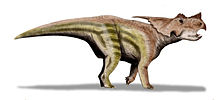Achelousaurus
| Achelousaurus | ||||||||||||
|---|---|---|---|---|---|---|---|---|---|---|---|---|

Life reconstruction of Achelousaurus |
||||||||||||
| Temporal occurrence | ||||||||||||
| Upper Cretaceous (late Campanium ) | ||||||||||||
| 76.4 to 72 million years | ||||||||||||
| Locations | ||||||||||||
| Systematics | ||||||||||||
|
||||||||||||
| Scientific name | ||||||||||||
| Achelousaurus | ||||||||||||
| Sampson , 1995 | ||||||||||||
| Art | ||||||||||||
|
||||||||||||
Achelousaurus is a genus of pelvic dinosaurs from the group of Ceratopsidae within the Ceratopsia .
features
With an estimated length of 6 meters, Achelousaurus was a medium-sized representative of the Ceratopsidae. His physique resembled that of the other dinosaurs in this group. They were sturdy animals with strong limbs, the hind legs being significantly longer than the front legs.
The head was big and massive. The snout was pointed and, like all Ceratopsia, was formed from the rostral bone (in front of the upper jaw) and the predentals (in front of the lower jaw). As with all Ceratopsidae, the dentition consisted of tooth batteries, these are teeth arranged in rows, which were replaced by the following tooth when they were worn out. Like all Ceratopsia, it was herbivorous.
In contrast to most related Centrosaurinae, there was no horn on the nasal bone , but a thickened, bony hump. There was also a relatively high crest of bone above each eye. These structures were probably used when dealing with conspecifics, possibly about territories or mating privileges.
As with all Ceratopsidae, the neck shield was formed from the parietal and scaled bones . It was thin and had a pair of windows. There were two large spikes on the back edge of the shield.
Discovery and naming
From Achelousaurus three partially preserved are the skull and a partially preserved body skeleton known. The fossil remains were discovered in the Two Medicine Formation in the US state of Montana and first described in 1995 . The genus name is derived from the Greek river god Achelous, whose horn was broken off in the legend of Herakles - an allusion to the missing horns in this dinosaur, unlike in related species. The type and only known species is A. horneri . The finds are dated in the Upper Cretaceous (late Campanium ) to an age of about 76 to 72 million years.
Systematics
Achelousaurus is incorporated into the Centrosaurinae within the Ceratopsidae . Its closest relative is likely to have been the Pachyrhinosaurus , also characterized by the missing nasal horn . Together they formed the Pachyrhinosaurini tribe . Naish cladogram:
| Centrosaurinae |
|
||||||||||||||||||||||||
|
|
|
||||||||||||||||||||||||||||||||||||||||||||||||||||||||||||||||||||||||||||||||||||||||||
| Systematic position of Achelousaurus according to Evans & Ryan (2015). |
In 2015, the family tree of the Centrosaurinae was revised by Evans & Ryan (2015) on the occasion of the first description of the Wendiceratops found in Canada . Accordingly, the Pachyrhinosaurini were confirmed and Achelousaurus is the sister genus of Pachyrhinosaurus , the common sister genus is Einiosaurus . He was also placed in this position in a phylogenetic analysis in 2012.
literature
- Peter Dodson , Catherine A. Forster, Scott D. Sampson: Ceratopsidae. In: David B. Weishampel , Peter Dodson, Halszka Osmólska (eds.): The Dinosauria . 2nd edition. University of California Press, Berkeley CA et al. 2004, ISBN 0-520-24209-2 , pp. 494-513.
Individual evidence
- ^ Gregory S. Paul : The Princeton Field Guide To Dinosaurs. Princeton University Press, Princeton NJ et al. 2010, ISBN 978-0-691-13720-9 , p. 263, online .
- ↑ Darren Naish: The Fascinating Discovery of the Dinosaurs. Konrad Theiss, Stuttgart 2010, ISBN 978-3-8062-2325-5 .
- ↑ David C. Evans , Michael J. Ryan : Cranial Anatomy of Wendiceratops pinhornensis gen. Et sp. nov., a Centrosaurine Ceratopsid (Dinosauria: Ornithischia) from the Oldman Formation (Campanian), Alberta, Canada, and the Evolution of Ceratopsid Nasal Ornamentation. In: PLOS ONE. Volume 10, No. 7, e0130007, doi: 10.1371 / journal.pone.0130007 .
- ↑ Michael J. Ryan, David C. Evans, Kieran M. Shepherd: A New Ceratopsid from the Foremost Formation (Middle Campanian) of Alberta. In: Canadian Journal of Earth Sciences . Volume 49, No. 11, 2012, ISSN 0008-4077 , pp. 1251-1262, doi: 10.1139 / e2012-056 .
